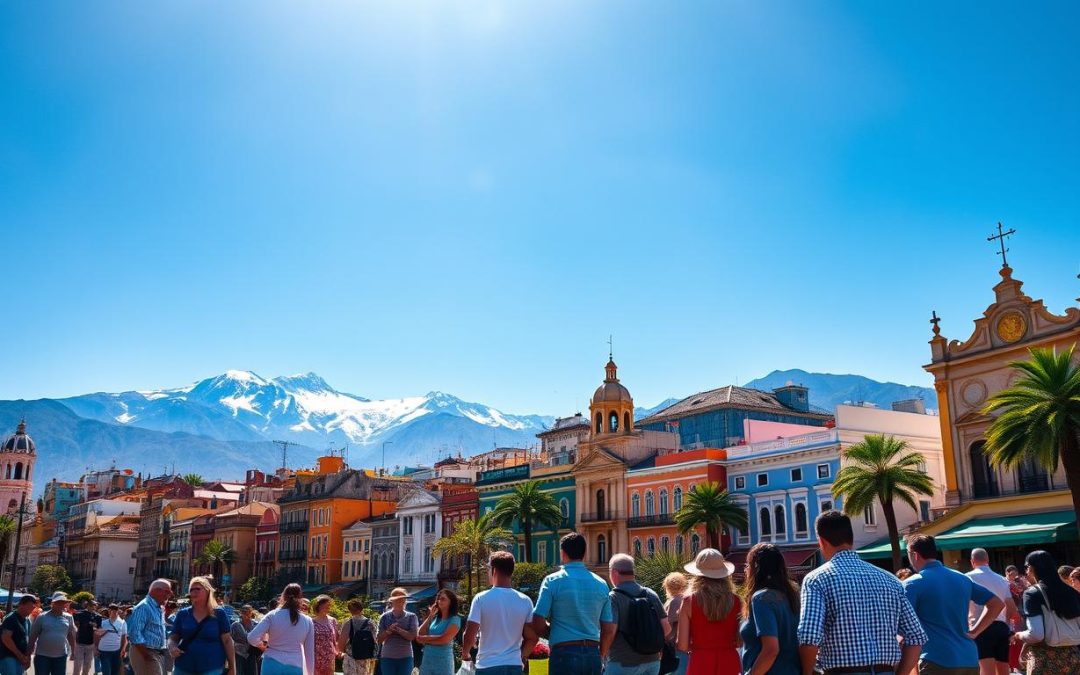Did you know Argentina’s language scene is more complex than just Spanish? The country’s language mix includes indigenous, immigrant, and colonial influences. These elements tell a story of cultural identity.
Spanish is the main language in Argentina, with almost 45 million people speaking it. The Rioplatense Spanish dialect, spoken by 19 million in Buenos Aires, makes Argentine Spanish unique.
Argentina’s language diversity goes beyond Spanish. There are 15 Indigenous American languages still spoken today. The country also has a mix of immigrant languages, showing its rich multicultural heritage. From Guaraní in the north to Mapudungun in the southwest, Argentina’s language map is diverse.
Key Takeaways
- Spanish is the predominant language in Argentina, spoken by over 45 million people
- Rioplatense Spanish is a unique dialect with 19 million speakers
- Argentina hosts 15 Indigenous American languages
- The country has a rich linguistic diversity from immigrant communities
- Multiple regional dialects exist across different provinces
Overview of Argentina’s Linguistic Landscape
Argentina is a multilingual society with a rich cultural heritage. Its language landscape is a mix of history and immigration. Exploring Argentina’s languages shows a complex and changing world of communication.
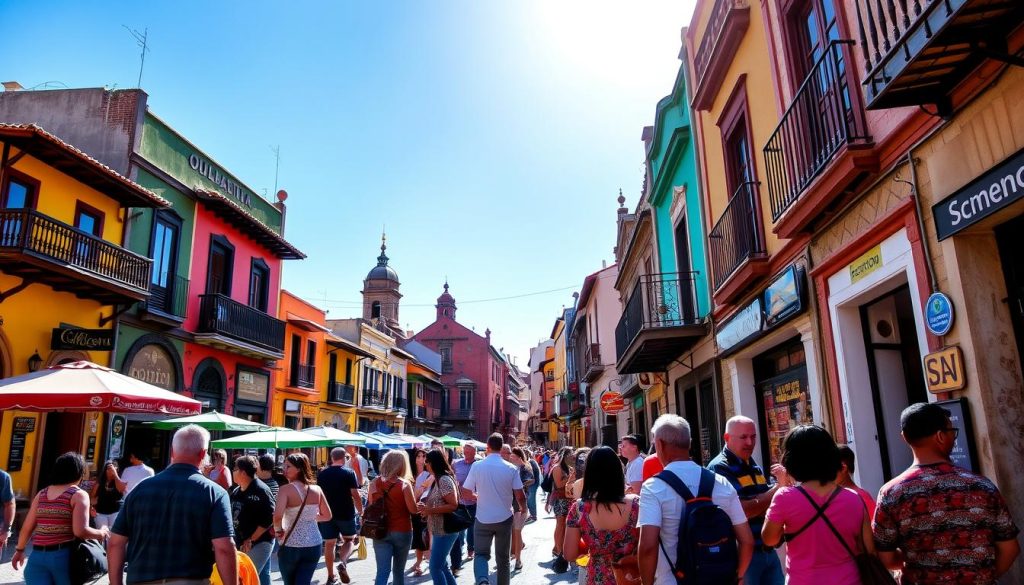
To understand Argentina’s language policy, we must look at its linguistic rights and multicultural background. The country is a great example of how different languages can live together and shape society.
Current Language Demographics
Argentina’s languages show amazing diversity:
- Spanish is the official and main language
- Indigenous languages like Mapudungun and Guarani are recognized
- There are also big communities of Italian, German, and Yiddish speakers
Historical Language Evolution
Argentina’s language history is shaped by its complex past. European settlers, especially from Italy and Spain, greatly influenced its language.
“Language is the road map of a culture. It tells you where its people come from and where they are going.” – Rita Mae Brown
Regional Language Distribution
| Region | Primary Languages | Cultural Influence |
|---|---|---|
| Buenos Aires | Spanish, Lunfardo | European immigrant impact |
| Northern Provinces | Spanish, Quechua, Guarani | Indigenous language preservation |
| Patagonia | Spanish, Welsh | European settlement legacy |
Today, Argentina celebrates its multilingual identity. It values linguistic diversity while keeping Spanish as the main language.
Spanish as the De Facto National Language
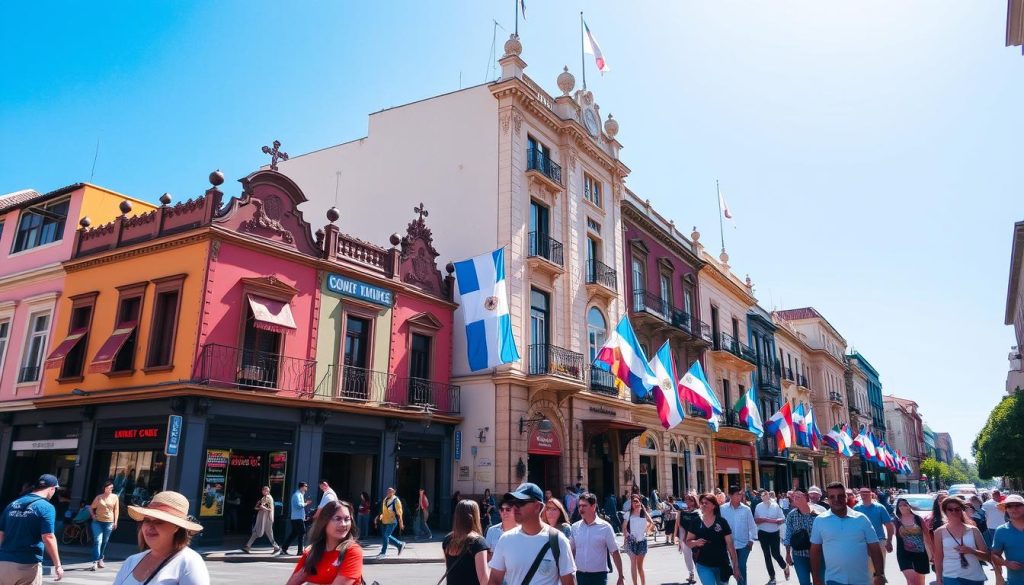
Spanish is the main language in Argentina, used by almost everyone. It shows the country’s deep history and culture. With about 40.9 million speakers, Argentina is a big part of the world’s Spanish-speaking community.
The Argentine Spanish has its own special features:
- Distinctive pronunciation shaped by Italian immigrants
- Local lunfardo slang adds to the vocabulary
- It has its own grammar rules, different from European Spanish
“Language is the road map of a culture. It tells you where its people come from and where they are going.” – Rita Mae Brown
Argentina’s Spanish has changed over time. It was shaped by indigenous languages and European immigrants. This language brings people together, from big cities to small towns.
| Spanish Language Statistic | Argentina Context |
|---|---|
| Native Speakers Worldwide | 488 million |
| Argentina’s Spanish Speakers | 40.9 million |
| Official Status in Argentina | De Facto National Language |
Learning Argentine Spanish is more than just talking. It’s a way to understand the heart of Argentina. It shows the lively spirit and rich culture of its people.
Argentina: Official and Widely Spoken Languages
Argentina’s language scene is rich and varied. It shows the country’s complex cultural background. Knowing about language use helps us understand how people communicate in different parts of this lively South American country.
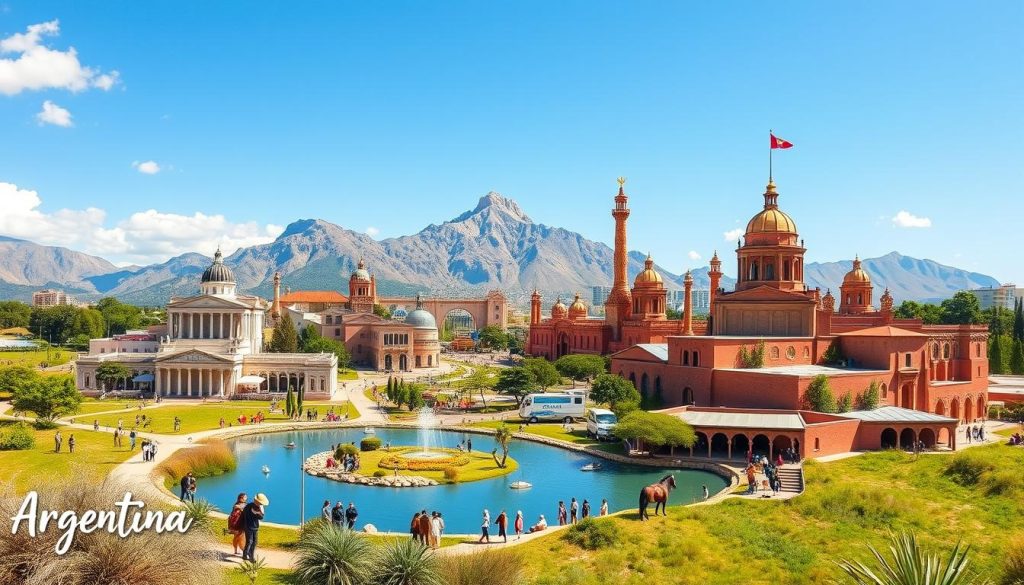
Primary Languages Statistics
Spanish is the main language in Argentina, with about 97% of people speaking it. The country has its own Spanish version, called Rioplatense Spanish. This version is known for using voseo a lot.
- Official language: Spanish
- Population speaking Spanish: 97%
- Total population: 45 million
- Indigenous language speakers: 3%
Language Usage by Region
Language use changes a lot across Argentina’s varied landscapes. Cities like Buenos Aires have a lot of language complexity. This is different from rural areas.
| Region | Primary Languages | Speakers |
|---|---|---|
| Buenos Aires Metro | Spanish, Italian, German | 19 million |
| Patagonia | Spanish, Indigenous languages | 2 million |
| Northern Provinces | Spanish, Quechua, Guarani | 4 million |
Urban vs Rural Language Distribution
In cities, more people speak multiple languages and get language education. About 15% of the population speaks English, with English taught in many schools. In rural areas, people often keep in touch with indigenous and traditional languages.
“Language is the roadmap of a culture. It tells you where its people come from and where they are going.” – Rita Mae Brown
Argentina’s language scene is always changing. It shows the country’s lively culture and ongoing immigration.
Indigenous Languages in Modern Argentina
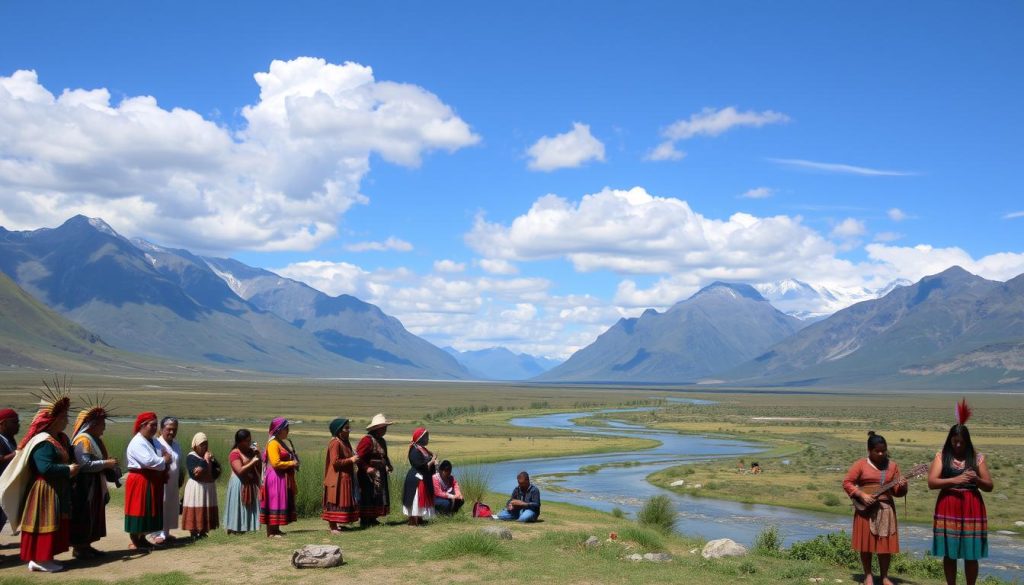
Argentina’s language scene is rich with indigenous tongues. These languages show the country’s deep cultural roots. Despite big hurdles, they keep alive in many areas, keeping the unique identities of indigenous groups.
Today, Argentina sees 39 indigenous groups with their own languages. The top indigenous languages are:
- Guaraní
- Mapudungun
- Wichí
- Mocoví
- Quechua
- Toba Qom
Indigenous communities’ language rights are getting more attention. In 2004, Guaraní was made an official language in Corrientes Province. This was a big win for keeping languages alive.
“Language is the roadmap of a culture. It tells you where its people come from and where they are going.” – Rita Mae Brown
But, indigenous languages face big challenges. About two-thirds of languages from before Spanish came have vanished. Moving to cities, mixing with other cultures, and not getting enough education help erase these languages.
| Language Family | Active Languages | Extinct Languages |
|---|---|---|
| Tupi–Guaraní | Guaraní | Chané |
| Guaycuruan | Mocoví, Toba Qom | Abipón, Mbayá |
| Araucanian | Mapudungun | Allentiac |
The National Education Law backs Intercultural Bilingual Education (EIB). It aims to keep and grow indigenous languages. Your support for these language rights is key to saving these precious cultural gems.
European Language Influences
Argentina’s mix of languages comes from European roots. Waves of immigrants in the 19th and early 20th centuries brought many languages. These languages still shape Argentina’s culture today.
Italian Language: A Profound Impact
Italian has a big role in Argentina’s language scene. About 1.5 million people speak Italian as their first language. Italian has also changed how people speak Spanish in Argentina.
- Over 1.5 million Argentines speak Italian as their first language
- Italian immigration began in the 19th century
- Language has significantly influenced Argentine Spanish pronunciation and vocabulary
German-Speaking Communities
German-speaking communities in Argentina are also interesting. It’s estimated that 400,000 to 500,000 people speak German. They have kept their language and traditions alive in Argentina.
Welsh Language Heritage in Patagonia
In Patagonia, there’s a Welsh community that’s kept their language alive. Despite being a small group of about 5,000, they’ve preserved their language and culture for many years.
“Language is the roadmap of a culture. It tells you where its people come from and where they are going.” – Rita Mae Brown
These European languages add to Argentina’s rich language mix. They show how the country welcomes and blends different cultures.
Language Education and Policy
Argentina’s approach to language education is both dynamic and focused. The country has made big steps in teaching English and promoting multilingual learning.
Argentina’s language policy shows a deep commitment to language rights and education quality. The country ranks 15th in the world for English skills, leading Latin America in this area.
“Language is the roadmap of a culture. It tells you where its people come from and where they are going.” – Rita Mae Brown
- English is compulsory in Argentine schools since 1996
- 80% of undergraduate enrollments are in public universities with diverse language learning policies
- Approximately 2.5 million Argentines engage in self-study of English
The education system in Argentina focuses on both Spanish and foreign languages. It supports multilingual education through various programs and initiatives.
| Language Education Metrics | Statistic |
|---|---|
| English Proficiency Ranking | 15th Globally |
| Average TOEFL Score | 93 |
| Bilingual School Network | Extensive Nationwide Coverage |
Students get an education that values language diversity. Spanish remains the main language of instruction. The government’s policy supports both national identity and global communication skills.
Immigrant Languages and Communities
Argentina’s rich history of immigration has made it a multilingual society. Beyond Spanish, the country is home to many immigrant languages. Each community brings its own language and culture to Argentina.
Asian Language Communities
Asian languages have added to Argentina’s diversity. Chinese and Japanese communities are big in cities. Here are some key facts:
- Approximately 60,000 Chinese immigrants
- Around 32,000 Japanese speakers
- Growing Asian language communities in major cities like Buenos Aires
Middle Eastern Language Groups
Middle Eastern languages have also become part of Argentine culture. Levantine Arabic is a major minority language. It has about 1 million speakers, mostly from Mediterranean migrations.
Recent Immigration Trends
New immigration is changing Argentina’s language scene. Neighboring countries are adding to the mix. This brings new languages and makes Argentina’s diversity even richer.
“Language is the road map of a culture. It tells you where its people come from and where they are going.” – Rita Mae Brown
These immigrant languages are more than numbers. They are living stories that are changing Argentina’s culture.
Endangered Languages and Preservation Efforts
Argentina is working hard to save its rich language heritage. Many indigenous languages are at risk of disappearing. Only a few elderly speakers are left to keep these languages alive. It’s crucial to act fast to protect these languages and their cultural value.
Some of the most endangered indigenous languages in Argentina include:
- Vilela: Approximately 20 speakers
- Puelche: Just 5-6 speakers
- Tehuelche: Only 4 speakers
- Selk’nam: Merely 1-3 speakers
“Language is the roadmap of a culture. It tells you where its people come from and where they are going.” – Rita Mae Brown
Protecting these languages is a top priority. Governments and schools are creating plans to save them. They’re working on documenting and reviving these languages. This includes making archives, starting educational programs, and helping communities teach their languages.
| Language | Speakers | Preservation Status |
|---|---|---|
| Quechua | 800,000 | Actively Preserved |
| Guaraní | 200,000 | Moderately Preserved |
| Mapudungun | 100,000 | Limited Preservation |
You can help save these languages too. Learning about them, supporting cultural programs, and spreading the word are key. Together, we can make sure these languages live on for generations to come.
Conclusion
Argentina’s language diversity is more than just talking. It’s a complex mix of cultures that shows the country’s depth. You see a blend of indigenous, European, and evolving languages. This mix shows how language reflects culture and history.
Exploring Argentina’s language, you find Rioplatense Spanish is a story of cultural exchange. It has words from Italian and sounds unique. About 6% of people still speak indigenous languages like Guaraní and Quechua.
Argentina is working hard to keep its languages alive. Schools in places like Buenos Aires and Mendoza focus on this. They aim to celebrate the country’s diverse languages, looking to the future.
Understanding Argentina’s language journey shows a nation that values its culture. Language is seen as a living part of its heritage and ongoing growth.
The above is subject to change.
Check back often to TRAVEL.COM for the latest travel tips and deals.
Here are some Tours & Sightseeing suggestions that might pique your interests!
